
Brutalist architecture
Encyclopedia
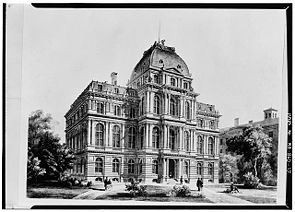
Architecture
Architecture is both the process and product of planning, designing and construction. Architectural works, in the material form of buildings, are often perceived as cultural and political symbols and as works of art...
which flourished from the 1950s to the mid 1970s, spawned from the modernist architectural
Modern architecture
Modern architecture is generally characterized by simplification of form and creation of ornament from the structure and theme of the building. It is a term applied to an overarching movement, with its exact definition and scope varying widely...
movement.
The term "brutalism"

.jpg)

Alison and Peter Smithson
English architects Alison Smithson and Peter Smithson together formed an architectural partnership, and are often associated with the New Brutalism .Peter was born in Stockton-on-Tees in north-east England, and Alison was born in Sheffield, South Yorkshire...
coined the term in 1953, from the French
French language
French is a Romance language spoken as a first language in France, the Romandy region in Switzerland, Wallonia and Brussels in Belgium, Monaco, the regions of Quebec and Acadia in Canada, and by various communities elsewhere. Second-language speakers of French are distributed throughout many parts...
béton brut
Béton brut
Béton brut is architectural concrete left unfinished or roughly-finished after pouring and left exposed visually. The imprint of the wood or plywood forms used for pouring is usually present on the final surface....
, or "raw concrete", a phrase used by Le Corbusier
Le Corbusier
Charles-Édouard Jeanneret, better known as Le Corbusier , was a Swiss-born French architect, designer, urbanist, writer and painter, famous for being one of the pioneers of what now is called modern architecture. He was born in Switzerland and became a French citizen in 1930...
to describe the poured board-marked concrete with which he constructed many of his post-World War II buildings. The term gained wide currency when the British architectural critic Reyner Banham
Reyner Banham
Peter Reyner Banham was a prolific architectural critic and writer best known for his 1960 theoretical treatise Theory and Design in the First Machine Age and for his 1971 book Los Angeles: The Architecture of Four Ecologies...
used it in the title of his 1966 book, The New Brutalism: Ethic or Aesthetic?, to characterize a somewhat recently established cluster of architectural approaches, particularly in Europe.
The architectural style known as Brutalism and the architectural and urban theory known as New Brutalism may be regarded as two different movements, although the terms are often used interchangeably. The New Brutalism of the British members of Team 10, Alison and Peter Smithson, is more related to the theoretical reform of the CIAM
Congrès International d'Architecture Moderne
The Congrès internationaux d'architecture moderne – CIAM was an organization founded in 1928 and disbanded in 1959, responsible for a series of events and congresses arranged around the world by the most prominent architects of the time, with the objective of spreading the principles of the Modern...
(in architecture and urbanism) than to "béton brut". Reyner Banham
Reyner Banham
Peter Reyner Banham was a prolific architectural critic and writer best known for his 1960 theoretical treatise Theory and Design in the First Machine Age and for his 1971 book Los Angeles: The Architecture of Four Ecologies...
formulated this difference in the title of his book: The New Brutalism - Ethic or Aesthetic?
Characteristics

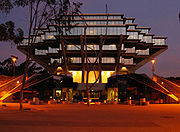
Concrete
Concrete is a composite construction material, composed of cement and other cementitious materials such as fly ash and slag cement, aggregate , water and chemical admixtures.The word concrete comes from the Latin word...
is used, often revealing the texture of the wooden forms used for the in-situ casting. Although concrete is the material most widely associated with Brutalist architecture, not all Brutalist buildings are formed from concrete. Instead, a building may achieve its Brutalist quality through a rough, blocky appearance, and the expression of its structural materials, forms, and (in some cases) services on its exterior. For example, many of Alison and Peter Smithson's private houses are built from brick. Brutalist building materials also include brick, glass, steel, rough-hewn stone, and gabion
Gabion
Gabions are cages, cylinders, or boxes filled with soil or sand that are used in civil engineering, road building, and military applications. For erosion control caged riprap is used. For dams or foundation construction, cylindrical metal structures are used...
(also known as trapion). Conversely, not all buildings exhibiting an exposed concrete exterior can be considered Brutalist, and may belong to one of a range of architectural styles including Constructivism
Constructivist architecture
Constructivist architecture was a form of modern architecture that flourished in the Soviet Union in the 1920s and early 1930s. It combined advanced technology and engineering with an avowedly Communist social purpose. Although it was divided into several competing factions, the movement produced...
, International Style
International style (architecture)
The International style is a major architectural style that emerged in the 1920s and 1930s, the formative decades of Modern architecture. The term originated from the name of a book by Henry-Russell Hitchcock and Philip Johnson, The International Style...
, Expressionism
Expressionist architecture
Expressionist architecture was an architectural movement that developed in Europe during the first decades of the 20th century in parallel with the expressionist visual and performing arts....
, Postmodernism, and Deconstructivism
Deconstructivism
Deconstructivism is a development of postmodern architecture that began in the late 1980s. It is characterized by ideas of fragmentation, an interest in manipulating ideas of a structure's surface or skin, non-rectilinear shapes which serve to distort and dislocate some of the elements of...
.
Another common theme in Brutalist designs is the exposure of the building's functions—ranging from their structure and services to their human use—in the exterior of the building. In the Boston City Hall
Boston City Hall
Boston City Hall is the seat of the municipal government of Boston, Massachusetts. Architecturally, it is an example of the brutalist style. It was designed by Kallmann McKinnell & Knowles...
(illustration right), designed in 1962, the strikingly different and projected portions of the building indicate the special nature of the rooms behind those walls, such as the mayor's office or the city council chambers. From another perspective, the design of the Hunstanton School included placing the facility's water tank, normally a hidden service feature, in a prominent, visible tower.
Brutalism as an architectural philosophy, rather than a style, was often also associated with a socialist utopian ideology, which tended to be supported by its designers, especially Alison and Peter Smithson, near the height of the style. Critics argue that this abstract nature of Brutalism makes the style unfriendly and uncommunicative, instead of being integrating and protective, as its proponents intended. Brutalism also is criticised as disregarding the social, historic, and architectural environment of its surroundings, making the introduction of such structures in existing developed areas appear starkly out of place and alien. The failure of positive communities to form early on in some Brutalist structures, possibly due to the larger processes of urban decay
Urban decay
Urban decay is the process whereby a previously functioning city, or part of a city, falls into disrepair and decrepitude...
that set in after World War II (especially in the United Kingdom), led to the combined unpopularity of both the ideology and the architectural style.
History
The best known early Brutalist architecture is the work of the SwissSwitzerland
Switzerland name of one of the Swiss cantons. ; ; ; or ), in its full name the Swiss Confederation , is a federal republic consisting of 26 cantons, with Bern as the seat of the federal authorities. The country is situated in Western Europe,Or Central Europe depending on the definition....
architect
Architect
An architect is a person trained in the planning, design and oversight of the construction of buildings. To practice architecture means to offer or render services in connection with the design and construction of a building, or group of buildings and the space within the site surrounding the...
Le Corbusier
Le Corbusier
Charles-Édouard Jeanneret, better known as Le Corbusier , was a Swiss-born French architect, designer, urbanist, writer and painter, famous for being one of the pioneers of what now is called modern architecture. He was born in Switzerland and became a French citizen in 1930...
, in particular his Unité d'Habitation
Unité d'Habitation
The Unité d'Habitation is the name of a modernist residential housing design principle developed by Le Corbusier, with the collaboration of painter-architect Nadir Afonso...
(1952) and the 1953 Secretariat Building in Chandigarh
Chandigarh
Chandigarh is a union territory of India that serves as the capital of two states, Haryana and Punjab. The name Chandigarh translates as "The Fort of Chandi". The name is from an ancient temple called Chandi Mandir, devoted to the Hindu goddess Chandi, in the city...
, India.
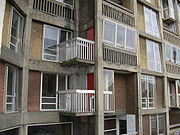
Combined with the socially progressive
Progressivism
Progressivism is an umbrella term for a political ideology advocating or favoring social, political, and economic reform or changes. Progressivism is often viewed by some conservatives, constitutionalists, and libertarians to be in opposition to conservative or reactionary ideologies.The...
intentions behind Brutalist streets in the sky housings such as Corbusier's Unité, Brutalism was promoted as a positive option for forward-moving, modern urban housing. In practice, however, many of the buildings built in this style lacked many of the community-serving features of Corbusier's vision, and instead, developed into claustrophobic, crime-ridden tenements. Robin Hood Gardens
Robin Hood Gardens
Robin Hood Gardens is a council housing complex in Poplar, London designed in the late 1960s by architects Alison and Peter Smithson and completed in 1972...
is a particularly notorious example, although the worst of its problems have been overcome in recent years. Some such buildings took decades to develop into positive communities. The rough coolness of concrete lost its appeal under a damp and gray northern sky, and its fortress-like material, touted as vandal-proof, soon proved vulnerable to spray-can graffiti
Graffiti
Graffiti is the name for images or lettering scratched, scrawled, painted or marked in any manner on property....
.
Figures
In the United Kingdom, Architects associated with the Brutalist style include Ernő GoldfingerErno Goldfinger
Ernő Goldfinger was a Hungarian-born Jewish architect and designer of furniture, and a key member of the architectural Modern Movement after he had moved to the United Kingdom.-Biography:Goldfinger was born in Budapest...
, wife-and-husband pairing Alison and Peter Smithson
Alison and Peter Smithson
English architects Alison Smithson and Peter Smithson together formed an architectural partnership, and are often associated with the New Brutalism .Peter was born in Stockton-on-Tees in north-east England, and Alison was born in Sheffield, South Yorkshire...
, Richard Seifert
Richard Seifert
Reubin Seifert - normally known as Richard Seifert was a British architect, best known for designing the Centrepoint tower and Tower 42 , once the tallest building in the City of London...
, Basil Spence
Basil Spence
Sir Basil Urwin Spence, OM, OBE, RA was a Scottish architect, most notably associated with Coventry Cathedral in England and the Beehive in New Zealand, but also responsible for numerous other buildings in the Modernist/Brutalist style.-Training:Spence was born in Bombay, India, the son of Urwin...
, John Bancroft
John Bancroft (architect)
John Bancroft was a British architect noted for his Brutalist designs for the Greater London Council.He joined the Architects’ Department of the GLC in 1957 and led the project to build Pimlico School from 1964 to 1970....
and, to a lesser extent perhaps, Sir Denys Lasdun
Denys Lasdun
Sir Denys Lasdun CH was an eminent English architect. Probably his best known work is the Royal National Theatre, on London's South Bank of the Thames, which is a Grade II* listed building and one of the most notable examples of Brutalist design in the United Kingdom.Lasdun studied at the...
.
In Australia, three examples of the Brutalist style described as the country's finest are Robin Gibson's Queensland Art Gallery
Queensland Art Gallery
The Queensland Art Gallery is part of the Queensland Cultural Centre, and is located nearest to Brisbane River at South Bank...
, Ken Woolley's
Ken Woolley
Ken F. Woolley AM, B.Arch LAIA, is an influential Australian architect. In a career spanning more than 50 years, he is best known for his contributions to project housing with Pettit and Sevitt, the Wilkinson Award winning Woolley House in Mosman, and his longstanding partnership with Sydney...
Fisher Library
University of Sydney Library
The University of Sydney Library is the library system of the University of Sydney. According to its publications, it is the largest academic library in the southern hemisphere, with a print collection of over 5.1 million items . It is composed of twelve libraries across eight campuses of the...
at the University of Sydney (his State Office Block is another) and the High Court of Australia
High Court of Australia
The High Court of Australia is the supreme court in the Australian court hierarchy and the final court of appeal in Australia. It has both original and appellate jurisdiction, has the power of judicial review over laws passed by the Parliament of Australia and the parliaments of the States, and...
by Colin Madigan
Colin Madigan
Colin Frederick Madigan AO was an Australian architect. He is best known for designing the National Gallery of Australia in Canberra.-Biography:...
in Canberra
Canberra
Canberra is the capital city of Australia. With a population of over 345,000, it is Australia's largest inland city and the eighth-largest city overall. The city is located at the northern end of the Australian Capital Territory , south-west of Sydney, and north-east of Melbourne...
. John Andrews
John Andrews (architect)
John Hamilton Andrews is a Canadian and Australian architect.John Andrews graduated with a bachelors from the University of Sydney in 1956. In 1957 he entered the masters of architecture program at Harvard University. After graduation he worked with John Parkin in Don Mills, a suburb of Toronto,...
's government and institutional structures in Australia also exhibit the style.
In Asia there are government buildings by Louis Kahn
Louis Kahn
Louis Isadore Kahn was an American architect, based in Philadelphia, Pennsylvania, United States. After working in various capacities for several firms in Philadelphia, he founded his own atelier in 1935...
.
Paul Rudolph
Paul Rudolph (architect)
Paul Marvin Rudolph was an American architect and the dean of the Yale School of Architecture for six years, known for use of concrete and highly complex floor plans...
and Ralph Rapson
Ralph Rapson
Ralph Rapson was the head of architecture at the University of Minnesota for many years...
, from the United States are both noted Brutalists. Walter Netsch
Walter Netsch
Walter Netsch was an American architect based in Chicago. He was most closely associated with the brutalist style of architecture, as well as the firm of Skidmore, Owings, and Merrill. His signature aesthetic is known as Field Theory and is based on rotating squares into complex shapes...
is known for his Brutalist academic buildings (see above). Marcel Breuer
Marcel Breuer
Marcel Lajos Breuer , was a Hungarian-born modernist, architect and furniture designer of Jewish descent. One of the masters of Modernism, Breuer displayed interest in modular construction and simple forms.- Life and work :Known to his friends and associates as Lajkó, Breuer studied and taught at...
was known for his "soft" approach to the style, often using curves rather than corners. Clorindo Testa
Clorindo Testa
Clorindo Manuel José Testa is an Italian-Argentine architect and artist. He graduated from the School of Architecture at the Universidad de Buenos Aires in 1948....
in Argentina
Argentina
Argentina , officially the Argentine Republic , is the second largest country in South America by land area, after Brazil. It is constituted as a federation of 23 provinces and an autonomous city, Buenos Aires...
created the Bank of London and South America, one of the best examples of the fifties. More recent Modernists such as I.M. Pei and Tadao Ando
Tadao Ando
is a Japanese architect whose approach to architecture was once categorized by Francesco Dal Co as critical regionalism. Ando has led a storied life, working as a truck driver and boxer prior to settling on the profession of architecture, despite never having taken formal training in the field...
also have designed notable Brutalist works. In Brazil, the style is associated with the Paulista School
Paulista School
The Paulista School was an informal group of Brazilian architects who formed in the 1950s. As opposed to the smoother curvy surfaces of the Rio School typified by Oscar Niemeyer, the Paulista work embraced exposed concrete structures, chunkier massing, and rougher finishes.The two primary...
and is evident in the works of Pritzker Architecture Prize-winning architect Paulo Mendes da Rocha
Paulo Mendes da Rocha
Paulo Mendes da Rocha is a Brazilian architect, honored with the Mies van der Rohe Prize and the Pritzker Prize .Paulo attended the Universidade Presbiteriana Mackenzie College of Architecture, graduating in 1954...
(2006). In the Philippines, Leandro Locsin
Leandro Locsin
Leandro V. Locsin was a Filipino architect, artist, and interior designer, known for his use of concrete, floating volume and simplistic design in his various projects. An avid collector, he was fond of modern painting and Chinese ceramics. He was proclaimed a National Artist of the Philippines...
designed the massive brutalist structures, the Cultural Center of the Philippines
Cultural Center of the Philippines
The Cultural Center of the Philippines is a government-owned and controlled corporation established to preserve, develop and promote arts and culture in the Philippines. The CCP was established through Executive Order No. 30 s. 1966 by President Ferdinand Marcos...
and the Philippine International Convention Center
Philippine International Convention Center
The Philippine International Convention Center is a convention center located in the Cultural Center of the Philippines complex in Pasay City, Metro Manila, Philippines...
. In New Zealand, Sir Miles Warren and his practice Warren & Mahoney led the development of the so-called "Christchurch School" of architecture, which fused Brutalist architectural style with Scandinavian and Japanese values of straightforwardness. Warren's buildings have had a significant effect on New Zealand's public architecture.
On university campuses
In the late 1960s, many campuses in North America were undergoing expansions and, as a result, there are a significant number of Brutalist buildings at American and Canadian universities, beginning with Paul RudolphPaul Rudolph (architect)
Paul Marvin Rudolph was an American architect and the dean of the Yale School of Architecture for six years, known for use of concrete and highly complex floor plans...
's 1958 Yale Art and Architecture Building. Rudolph's design for the University of Massachusetts Dartmouth
University of Massachusetts Dartmouth
The University of Massachusetts Dartmouth is one of five campuses and operating subdivisions of the University of Massachusetts . It is located in North Dartmouth, Massachusetts, United States, in the center of the South Coast region, between the cities of New Bedford to the east and Fall River...
is an example of an entire campus designed from scratch in the Brutalist style. Likewise, architect Walter Netsch
Walter Netsch
Walter Netsch was an American architect based in Chicago. He was most closely associated with the brutalist style of architecture, as well as the firm of Skidmore, Owings, and Merrill. His signature aesthetic is known as Field Theory and is based on rotating squares into complex shapes...
designed the entire University of Illinois-Chicago Circle Campus (now the East Campus of the University of Illinois at Chicago
University of Illinois at Chicago
The University of Illinois at Chicago, or UIC, is a state-funded public research university located in Chicago, Illinois, United States. Its campus is in the Near West Side community area, near the Chicago Loop...
) under a single, unified brutalist design. The original "inner ring" of buildings at the University of California, Irvine
University of California, Irvine
The University of California, Irvine , founded in 1965, is one of the ten campuses of the University of California, located in Irvine, California, USA...
was designed by a team of architects led by William Pereira
William Pereira
William Leonard Pereira was an American architect from Chicago, Illinois, of Portuguese ancestry who was noted for his futuristic designs of landmark buildings such as the Transamerica Pyramid in San Francisco...
in what he called a "California Brutalist" style.
Criticism and reception
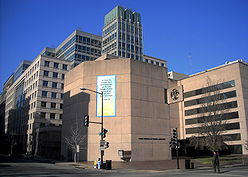
Charles, Prince of Wales
Prince Charles, Prince of Wales is the heir apparent and eldest son of Queen Elizabeth II and Prince Philip, Duke of Edinburgh. Since 1958 his major title has been His Royal Highness The Prince of Wales. In Scotland he is additionally known as The Duke of Rothesay...
. His speeches and writings on architecture have excoriated Brutalism, calling many of the structures "piles of concrete". "You have to give this much to the Luftwaffe
Luftwaffe
Luftwaffe is a generic German term for an air force. It is also the official name for two of the four historic German air forces, the Wehrmacht air arm founded in 1935 and disbanded in 1946; and the current Bundeswehr air arm founded in 1956....
", said Prince Charles at the Corporation of London Planning and Communication Committee's annual dinner at Mansion House
Mansion House, London
Mansion House is the official residence of the Lord Mayor of the City of London in London, England. It is used for some of the City of London's official functions, including an annual dinner, hosted by the Lord Mayor, at which the Chancellor of the Exchequer customarily gives a speech – his...
in December 1987. "When it knocked down our buildings, it didn't replace them with anything more offensive than rubble." Much of the criticism comes not only from the designs of the buildings, but also from the fact that concrete façades do not age well in damp, cloudy maritime climates such as those of northwestern Europe. In these climates, the concrete becomes streaked with water stains and sometimes with moss
Moss
Mosses are small, soft plants that are typically 1–10 cm tall, though some species are much larger. They commonly grow close together in clumps or mats in damp or shady locations. They do not have flowers or seeds, and their simple leaves cover the thin wiry stems...
and lichen
Lichen
Lichens are composite organisms consisting of a symbiotic organism composed of a fungus with a photosynthetic partner , usually either a green alga or cyanobacterium...
s, and rust leaches from the steel reinforcing bars
Rebar
A rebar , also known as reinforcing steel, reinforcement steel, rerod, or a deformed bar, is a common steel bar, and is commonly used as a tensioning device in reinforced concrete and reinforced masonry structures holding the concrete in compression...
.
At the University of Oregon
University of Oregon
-Colleges and schools:The University of Oregon is organized into eight schools and colleges—six professional schools and colleges, an Arts and Sciences College and an Honors College.- School of Architecture and Allied Arts :...
campus, outrage and vocal distaste for Brutalism led, in part, to the hiring of Christopher Alexander
Christopher Alexander
Christopher Wolfgang Alexander is a registered architect noted for his theories about design, and for more than 200 building projects in California, Japan, Mexico and around the world...
and the initiation of The Oregon Experiment
The Oregon Experiment
The Oregon Experiment is a 1975 book by Christopher Alexander and collaborators Murray Silverstein, Shlomo Angel, Sara Ishikawa, and Denny Abrams...
in the late 1970s. This led to the development of Alexander's A Pattern Language
A Pattern Language
A Pattern Language: Towns, Buildings, Construction is a 1977 book on architecture, urban design, and community livability. It was authored by Christopher Alexander, Sara Ishikawa and Murray Silverstein of the Center for Environmental Structure of Berkeley, California, with writing credits also to...
and A Timeless Way of Building.
In recent years, the bad memories of under-served Brutalist community structures have led to their demolition
Demolition
Demolition is the tearing-down of buildings and other structures, the opposite of construction. Demolition contrasts with deconstruction, which involves taking a building apart while carefully preserving valuable elements for re-use....
in communities eager to make way for newer, more traditionally-oriented community structures. Despite a nascent modernist appreciation movement, and the identified success that some of this style's offspring have had, many others have been or are slated to be demolished.
Theodore Dalrymple, a British author, physican, and political commentator, has written for City Journal that brutalist structures represent an artifact of European philosophical totalitarianism
Totalitarianism
Totalitarianism is a political system where the state recognizes no limits to its authority and strives to regulate every aspect of public and private life wherever feasible...
, a "spiritual, intellectual, and moral deformity." He called the buildings "cold-hearted", "inhuman", "hideous", and "monstrous". He stated that the reinforced concrete
Concrete
Concrete is a composite construction material, composed of cement and other cementitious materials such as fly ash and slag cement, aggregate , water and chemical admixtures.The word concrete comes from the Latin word...
"does not age gracefully but instead crumbles, stains, and decays", which makes alternative building styles superior.
Brutalism today
Although the Brutalist movement was largely dead by the mid-1980s, having largely given way to Structural Expressionism and DeconstructivismDeconstructivism
Deconstructivism is a development of postmodern architecture that began in the late 1980s. It is characterized by ideas of fragmentation, an interest in manipulating ideas of a structure's surface or skin, non-rectilinear shapes which serve to distort and dislocate some of the elements of...
, it has experienced an updating of sorts in recent years. Many of the rougher aspects of the style have been softened in newer buildings, with concrete façades often being sandblasted to create a stone-like surface, covered in stucco
Stucco
Stucco or render is a material made of an aggregate, a binder, and water. Stucco is applied wet and hardens to a very dense solid. It is used as decorative coating for walls and ceilings and as a sculptural and artistic material in architecture...
, or composed of patterned, pre-cast elements. Modernist architects taking this approach in recent projects include Steven Ehrlich, Ricardo Legorreta
Ricardo Legorreta
Ricardo Legorreta Vilchis is a Mexican architect. He was born in Mexico City on May 7, 1931. He was awarded the prestigious UIA Gold Medal in 1999 and the Praemium Imperiale in 2011.He studied architecture at the Universidad Nacional Autónoma de México....
, and Gin Wong. The firm of Victor Gruen and Associates
Victor Gruen
Victor David Gruen, born Viktor David Grünbaum , was an Austrian-born commercial architect best known as a pioneer in the design of shopping malls in the United States.- Biography :...
has revamped the style for the many courthouse buildings it has been contracted to design. Architects from Latin America have been reviving the style on a smaller scale in recent years. Brutalism has recently experienced a major revival in Israel
Israel
The State of Israel is a parliamentary republic located in the Middle East, along the eastern shore of the Mediterranean Sea...
, due to the perceived sense of strength and security the style creates.
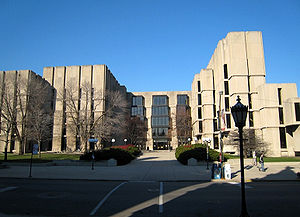
Lambeth
Lambeth is a district of south London, England, and part of the London Borough of Lambeth. It is situated southeast of Charing Cross.-Toponymy:...
, London, and Elder & Cannon's The Icon in Glasgow
Glasgow
Glasgow is the largest city in Scotland and third most populous in the United Kingdom. The city is situated on the River Clyde in the country's west central lowlands...
in Scotland. The 2005 Stirling Prize
Stirling Prize
The Royal Institute of British Architects Stirling Prize is a British prize for excellence in architecture. It is named after the architect James Stirling, organised and awarded annually by the Royal Institute of British Architects...
shortlist contained a number of buildings (most notably Zaha Hadid
Zaha Hadid
Zaha Hadid, CBE is an Iraqi-British architect.-Life and career:Hadid was born in 1950 in Baghdad, Iraq. She received a degree in mathematics from the American University of Beirut before moving to study at the Architectural Association School of Architecture in London.After graduating she worked...
's BMW Central Building
BMW Central Building
The BMW Central Building Located in Leipzig, Germany was the winning design submitted for competition by Pritzker Prize winning architect, Zaha Hadid. The central building is the nerve center for BMW's new $1.55 billion complex built to manufacture the BMW 3 Series Vehicle.-Concept:The BMW factory...
and the eventual winner, Enric Miralles
Enric Miralles
Enric Miralles Moya was a Spanish Catalan architect. He graduated from the School of Architecture of Barcelona at the Universitat Politècnica de Catalunya in 1978. After establishing his reputation with a number of collaborations with his first wife Carme Pinós, the couple separated in 1991...
' Scottish Parliament Building
Scottish Parliament Building
The Scottish Parliament Building is the home of the Scottish Parliament at Holyrood, within the UNESCO World Heritage Site in central Edinburgh. Construction of the building commenced in June 1999 and the Members of the Scottish Parliament held their first debate in the new building on 7...
) featuring significant amounts of exposed concrete, something that would have been regarded as aesthetically unacceptable when the prize was inaugurated nine years previously.
There also has been a reappraisal of first-generation Brutalist architecture and a growing appreciation that dislike of the buildings often stems from poor maintenance and social problems resulting from poor management, rather than the designs themselves. In 2005 the British television channel Channel 4
Channel 4
Channel 4 is a British public-service television broadcaster which began working on 2 November 1982. Although largely commercially self-funded, it is ultimately publicly owned; originally a subsidiary of the Independent Broadcasting Authority , the station is now owned and operated by the Channel...
ran a documentary, I Love Carbuncles, which placed the U.K.'s Brutalist legacy in a more positive light. Some Brutalist buildings have been granted listed status as historic and others, such as Gillespie, Kidd and Coia's St. Peter's Seminary
St. Peter's Seminary (Cardross)
St. Peter's Seminary is a disused Roman Catholic seminary near Cardross, Argyll and Bute, Scotland. Designed by the firm of Gillespie, Kidd and Coia, it has been described by the international architecture conservation organisation DOCOMOMO as a modern "building of world significance"...
, named by Prospect
Prospect (architecture magazine)
Urban Realm, formerly Prospect, is a quarterly architecture and planning magazine published in Scotland, with a focus on Scottish issues. The magazine was established as Prospect in 1922 by the Royal Incorporation of Architects in Scotland , and is the UK's oldest architectural magazine...
magazine's survey of architects as Scotland's greatest post-war building, have been the subject of conservation campaigns. The Twentieth Century Society has campaigned against the demolition of buildings such as the Tricorn Centre
Tricorn Centre
The Tricorn Centre was a Brutalist shopping, apartment, nightclub and car park complex in Portsmouth, Hampshire, England. It was designed by Owen Luder and Rodney Gordon and took its name from the site's shape which from the air resembled a Tricorne hat. Constructed in the mid-1960s, it was...
and Trinity Centre Multi-Storey Car Park
Trinity Centre Multi-Storey Car Park
Trinity Square was a shopping centre and multi-storey car park situated in Gateshead, North East England, demolished in 2010. It was particularly noted for the Brutalist design of its car park, designed by the Owen Luder Partnership. The concrete structure, which dominated the skyline of the town,...
.

